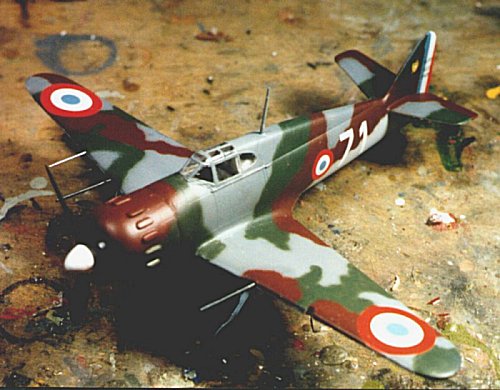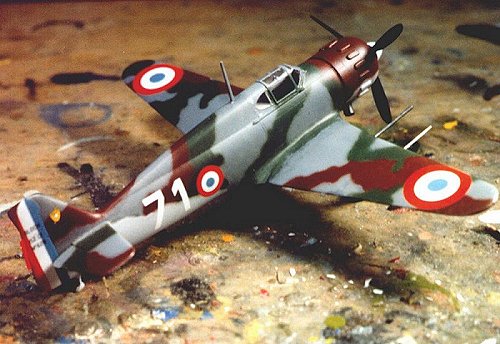
|
KIT: |
Classic Airframes 1/48 MB.152 |
|
KIT # |
|
|
PRICE: |
$29.95 |
|
DECALS: |
|
|
REVIEW & PHOTOS BY: |
|
|
NOTES: |
|
HISTORY |

It has been said that one can see the national origins of an airplane in its design. German and U.S. designs share a certain ruthlessly-efficient look (with the Germans more tolerant of idiosyncrasy in design than their American cousins), while the British have a certain funkiness often associated with their cars as well. No one can ever accuse the French of lack of originality; there are times one can argue in the history of French aircraft design that they have suffered from too much of a good thing!
In the late 1920s and early 1930s, French aircraft design led the world. The Dewoitine D.500 series pointed the way to the nouvelle vague of the single-seat, single-engine low wing monoplane. Unfortunately for the French, they undertook at exactly the wrong historical moment to engage in a socioeconomic program which involved massive nationalization of French industry, particularly that of the aviation industry. The loss of valuable months as a result of these dislocations turned into the loss of valuable years, and by the time war came in 1939, the native equipment of the Armee de l'Air was decidedly second-rate in comparison with that of Britain and most especially the enemy, Germany.
This situation was not due to lack of trying on the part of French designers; there simply was not enough time for the technical work and ironing out the inevitable bugs of a new airplane, while also dealing with the organizational fallout of the economic policies of the Popular Front.
Marcel Bloch had been involved in French aviation since the First World War, and his designs had been innovative and often successful during the Twenties and Thirties as he moved from company to company within the industry. The M.B.150 series began life in answer to the same specifications that led to the Dewoitine D.520, though Bloch elected to use a relatively untried radial engine for his bomber interceptor. The airplane was designed from the outset to carry the then-heavy armament of two 20mm cannon, which would be very effective against bombers. Unfortunately, from the outset the airplane was not designed for air-to-air combat, since so many leaders of both the French and British air forces believed that "the day of the fighter" was gone in the era of the high-speed monoplane and self-defending bomber. The result was an airplane with a high wing loading and lack of close-in maneuvering ability, unfortunately hobbled by an engine that did not put out the power originally expected. The M.B.150 was slow and couldn't get out of its own way because of this. It was also one of the only designs that came close to the specification, and there was no time to return to the drawing board. In a series of modifications in 1938-39, first the M.B.151 and then the M.B.152 appeared, and while the M.B.151 definitely didn't provide what was needed, the 152 got a little closer. It was thrown into production in late 1939, regardless, in an effort to fill the gap.
By May 1940, the airplane equipped only G.C.II, and only G.C.II/8 was close to having a full compliment of operational aircraft. The M.B.152 was deadly to the Do-17 and He-111 when it could find the bombers sans their Bf-109 escort, but it even had difficulty out-flying the Bf-110C of the destroyer squadrons. Following the armistice, the airplane became one of the two major types to equip l'Armee de l'Air de l'Armistice, the collaborationist Vichy Air Force. In 1941, it was removed from service and replaced completely by the D.520.
Marcel Bloch returned to aircraft design post-war, changing his name to Dassault - the nom de guerre created by his brother during his service in the wartime Resistance - and became the leader of the premiere French aviation company. Over the course of the following 20 years, Dassault consistently demonstrated that a privately-owned company was likely to stay closer to the cutting edge than a government bureaucracy that waited for the next specification to be issued.
|
THE KIT |
Classic Airframes has performed sterling service since its first release in bringing out models of airplanes that previously would only have seen the light of day as a vacuform, if that. The release this past summer of the M.B.152 and M.B.155 continued that, providing models of an important French fighter that had previously only been available as an expensive resin kit from J.M.G.T. in France.
|
CONSTRUCTION |

The kit comprises light grey limited-run injection-molded parts, with cast resin wheel wells, cockpit and engine. As is usual, two nicely done vacuform canopies are provided. When building this kit, it is important for the modeler to sand down the fuselage halves in the vicinity of the cockpit, and to also sand down the resin cockpit walls, as much as possible to thin these parts. If not, the cockpit will be stuffed between walls that are too thick, and will, as a result, become virtually invisible. This is not mentioned in the instructions, and is not always necessary in a limited-run kit, but it is definitely the case here.
Assembly is straightforward for a limited-run kit, and the parts fit well. The modeler will need to use putty on all the joints, and the result will look good since the petite surface detailing is easily rescribed where it is lost in this process. I did apply a rudder trim tab made of plastic sheet to replace the incorrect item in the kit.
|
PAINT & DECALS |

The airplane was really painted free-hand with spray guns for its camouflage, but I have found recently that one can do better in 1/48 scale if they mask off the various colors and spray. What I do is run a length of thread about 1/16' in from the edge of the tape I have trimmed, so that it stands proud of the surface when applied in position. By varying the angle of the airbrush, a bit of overspray can be achieved while keeping things neat-looking, and maintaining enough control to get the pattern desired in the end. I followed the pattern shown on the very nice full-color three-view painting and marking guide, and was happy with the result.
Classic Airframes has stopped using decals made by Propagteam - with their propensity to stick diligently to the first surface they touch - with MicroScale decals. I think from photos I have seen of the real thing in both the old Profile Publication and the French aviation magazine "Le Fana de l'Aviation," that the national insignia for the wings may be too large. However, I did not have anything to replace them with and moved on.
|
CONCLUSIONS |
